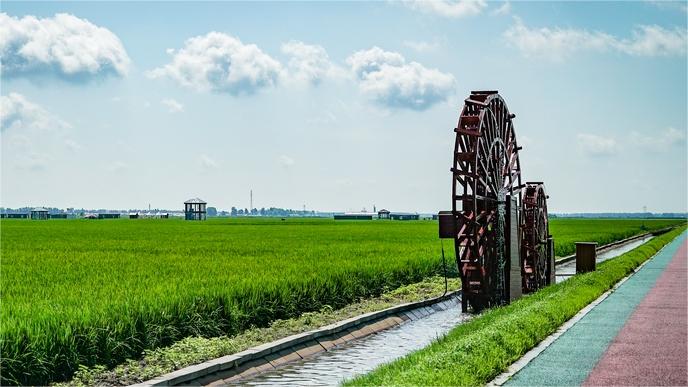Q&A on China reforms: When the rubber meets the road -- Decoding new quality productive forces
BEIJING, Aug. 20 (Xinhua) -- This summer, fruit fans in Singapore and the United Arab Emirates are in for a treat as they have easier access to yangmei, also known as waxberries. These small, crimson and sweet fruits are native to China and predominantly grown in Zhejiang Province.
In the past, despite its popularity in China, yangmei has not been widely exported due to its delicate and perishable nature. However, recent advancements in Zhejiang's yangmei cultivation industry, which boasts a history of over 1,600 years, have now made it possible to export this beloved seasonal fruit on a larger scale.
"By using electromagnetic waves to rearrange water molecules, we can lower the icing point to minus five degrees Celsius," said Ying Jiaoming, a chief technician at an agricultural technology firm in Xianju County. "This technology enables us to keep the storage temperatures below zero without actually freezing the fruits."
According to Ying, the technology has successfully extended the storage life of yangmei from seven days to over a month, thereby, helping the local specialty reach distant markets. From 2021 to 2023, Xianju's yangmei exports nearly tripled.
The fruit's tech-fueled global journey exemplifies China's efforts to foster new quality productive forces -- instead of discarding traditional industries, the country is looking to revitalize them with technological innovations tailored to local development needs.
Despite arising from sci-tech innovation, the concept of new quality productive forces extends beyond science and technology. Nicholas Welch, a regular columnist with the ChinaTalk newsletter, wrote recently that the concept may sound esoteric, but its connotation is simple: as a country's technology advances, its social and economic systems need to evolve accordingly.
That much-expected evolution is part of China's newly released reform blueprint. To cement reform consensus, a guidebook of articles by senior officials was published this summer, offering authoritative insights into the country's efforts to deepen reforms comprehensively.
Using the book as a reference, Xinhua delves into new quality productive forces, as well as the wide-ranging reforms the concept has sparked.
WHY DOES CHINA DEVELOP NEW QUALITY PRODUCTIVE FORCE?
For the Chinese leadership, developing new quality productive forces can address a series of challenges from home and abroad as the country pursues modernization.
The Chinese economy has made strides in recent years, but its growth remains unbalanced and uneven, with insufficient innovation capabilities and a widening income gap, says Vice Premier He Lifeng in his recent article incorporated in the book.
As resource and environmental pressures mount, traditional production methods and growth models are becoming increasingly outdated. Against this backdrop, China must upgrade its productive forces through technological innovation to create new growth momentum.
Meanwhile, the world is undergoing a new wave of technological and industrial revolutions. China is hoping to gain a competitive edge in advanced industries such as IT, biotech and new energy.
In the vice premier's words, the importance of cultivating new quality productive forces must be evaluated from a holistic and historical perspective. The country must seize every opportunity presented by these technological and industrial revolutions to ignite a surge in productivity.
In fact, analysts have noted that translating technological advances into enhanced productivity is the country's most pressing task at present.
Zheng Yongnian, a professor at the Chinese University of Hong Kong (Shenzhen), said that although China boasts the world's most comprehensive industrial system and a wide range of technologies, the added value of its products is still relatively low.
To increase its added value, the country must pursue tech-driven industrial upgrading, which is the essence of cultivating new quality productive forces, Zheng said.
HOW WILL CHINA DEVELOP THESE FORCES?
As an undertaking encompassing economic, social and ideological dimensions, the development of new quality productive forces necessitates comprehensive and profound changes in how people produce, live and think.
For the world's second-largest economy, the paramount task is to channel production factors such as labor, capital, land, knowledge and technology toward the development of new quality productive forces.
He Lifeng, in his article, calls on the whole nation to support entrepreneurship, allowing entrepreneurs to unlock their creativity and initiative in allocating resources. Meanwhile, businesses across all sectors of ownership should be encouraged to explore new opportunities and develop new products and technologies, as part of efforts to cultivate new quality productive forces.
The country should seek to strengthen talent exchanges among universities, research institutions and enterprises to better align the development of creative and skilled professionals with market demands, he said.
Efforts should also focus on enhancing financial services for sci-tech innovation, attracting diverse capital investments, and empowering researchers to have a greater voice in the allocation of earnings derived from their sci-tech achievements, the vice premier said.
The development of new quality productive forces hinges on sci-tech innovation. Committed to an innovation-driven development strategy, China has witnessed significant technological progress in recent years, with its Global Innovation Index ranking ascending from 34 in 2012 to 12 in 2023.
However, despite its technological strides, China's capability for original innovation remains relatively weak, and the returns on its sci-tech investments are not yet sufficient, says Huang Kunming, a member of the Political Bureau of the Communist Party of China (CPC) Central Committee and secretary of the CPC Guangdong Provincial Committee.
According to Huang, the country continues to face significant bottlenecks in key core technologies, which could impede its future development. "Promoting high-level self-reliance and self-strengthening in science and technology is not just a matter of development, but also a matter of survival," he says in an article.
To address these challenges, the country, while leveraging the government's pivotal role in providing guidance, must maximize the advantages of its vast domestic market, allowing the market to guide research and development, resource allocation, and technological advancements, Huang said. He noted that the market provides ample application scenarios for technologies, thereby helping identify the most promising new technologies, products and business models.
Additionally, the country should work to integrate innovation, industry, investment and talent to ensure that technological breakthroughs are applied to specific industries and supply chains in a timely and effective manner, he said.
Wu Hailong, chairman of Grand Union of Innovation Service Platform Co Ltd, said that with sci-tech innovation rapidly advancing nationwide, transforming innovative outcomes into reality demands an increasingly diverse range of resources and support.
Therefore, it is crucial to accelerate the integration of government, industries, academia, research institutions, financial institutions, service providers, and application scenarios. Moreover, fostering interaction among these stakeholders through a market-oriented approach is essential, Wu said.
To push forward China's innovation drive, the central bank has recently pledged an array of financial support measures for sci-tech innovation. Key measures include boosting re-lending for major national sci-tech projects and small tech companies and fostering an innovation-friendly financial environment.
The bank also aims to direct more funds toward the development of practical technologies and to meet the financing needs of enterprises at every stage of their growth.
WHAT ARE THE PAIN POINTS?
Given China's size and diversity, developing new quality productive forces is a long and arduous mission that requires systematic planning and appropriate approaches to succeed.
From China's perspective, developing new quality productive forces does not mean discarding all traditional ones. Instead, the country aims to rejuvenate traditional industries through sci-tech innovations tailored to local development needs.
Traditional industries are not necessarily obsolete. Through technological breakthroughs and industrial upgrades, they can also evolve into new quality productive forces, says He Lifeng. The priority in developing new quality productive forces is improving the quality of growth, rather than simply increasing growth models, he says, stressing that these forces can only thrive when rooted in the real economy.
A prime example is the city of Tianjin, a manufacturing powerhouse in north China, where local manufacturers are embracing automation. At Vitesco Automotive Tianjin Co., Ltd., an auto parts supplier, robots swiftly maneuver their mechanical arms and navigate through stacks of goods in a warehouse.
"This is our fully automatic logistics warehouse, which began operations at the end of last year," said general manager Cao Zhenqi. By integrating robotics technologies, 5G and the Internet of Things, the warehouse has increased its operational efficiency by 50 percent.
As a sweeping technological revolution unfolds across China, over 80 percent of major industrial companies nationwide have adopted digital technologies in their daily operations. The country also boasts more than 400 national-level intelligent manufacturing factories powered by artificial intelligence.
Although technological advancements are key to new quality productive forces, He Lifeng notes in his article that local governments must follow the normal patterns of technological innovation and industrial development, and adhere to the principle of "pursuing progress while ensuring stability."
"Regions with strong economic foundations, robust research capabilities and excellent innovation environments should swiftly establish themselves as key hubs for new quality productive forces. Meanwhile, areas currently lacking such conditions should progress at a slower, steadier pace. They should avoid hastily pursuing ambitious or foreign projects that exceed practical capabilities," the vice premier said.
Additionally, the government can play a better role in strategic planning, policy guidance, rule-making, and fiscal support, fostering a tolerant and flexible environment for innovation.
China should also hold fast to its opening-up policy, working to attract high-quality capital, key resources, advanced technologies, and top talent from around the world. By leveraging global innovation resources and outcomes, the country can develop new quality productive forces more efficiently, he says.
Photos
Related Stories
- Immunotech Biopharm highlights China's push for new quality productive forces
- 19 fresh professions released in China to keep pace with demand of new quality productive forces
- Powering new quality productive forces: Quantum technology
- Powering new quality productive forces: AI
- China unleashes new quality productive forces in push for reform, innovation
Copyright © 2024 People's Daily Online. All Rights Reserved.









